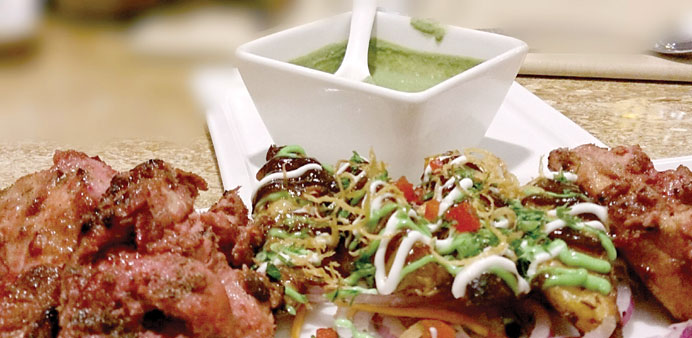MELTS IN YOUR MOUTH: Kandhari Murg is so soft it needs no knife to cut.
By Umer Nangiana
The moment you get ‘smoking tea riddle’ for the welcome drink, you know you are in for a palatial gastronomic experience. By the time you resolve the ‘riddle’ in the drink, the first surprise arrives. It is Amuse Bouche, the deconstructed Pani Puri, the traditional Indian street snack.
Involving the concept of molecular gastronomy or culinary physics, the famous pani puri comes in a single package, with pani, the green tamarind chutney enclosed in a bite-sized crispy deep fried hollow sac served with chickpeas.
It bursts in your mouth, releasing an instant tinge of chilli and chaat masala straight down your throat. Next comes Chaat Nucleua, prepared live. It is the traditional bhel puri again prepared using scientific culinary techniques involving liquid nitrogen.
Do not forget to take the biscuits stored in liquid nitrogen before you taste the Bhel Puri. It will refresh your taste buds. This progressive concept of cooking involving molecular gastronomy alongside the traditional Indian palate is being introduced at Zaffran Dining Experience, the newest addition to Doha’s Indian fine-dining options.
Offering a wide range of traditional Indian dishes, with and without the scientific tweaks, this new project by the popular Zaffran Café is the brainchild of its owner and Managing Director, Nitin Shroff, an Indian expat.
“Astronomy Chaat is something different. If I tell you Bhel Puri, what comes to your mind? What you get in Zaffran café, right? So we just wanted to change that picture,” says Shroff, speaking to Community about the introduction of molecular gastronomy in some of the appetizers the new restaurant offers on its menu.
One appetite stimulant is Kandhari Murg, a chicken dish. “It is also prepared using a bit of molecular science. We dehydrate the chicken and then rehydrate it. That allows you not to use the knife even,” claims Shroff. You really do not need to use knife, ideal for those who prefer to use just hand for eating. The fork will do the trick.
Shroff says he did everything by himself doing a bit research, mostly online and then taught it to his chefs.
“My chefs are very experienced but that is in traditional cooking. If I have to overnight change the way they think about Pani Puri for instance, it would have been impossible. I had to learn to make it. So I did and made it in front of them. They saw it, accepted it and then we designed the menu and today we are serving it,” explains the restaurateur.
Preparing Pani Puri, using the molecular science technique is a very lengthy process, says Shroff. It takes around 3-4 hours. How does it work? “You have to mix the calcium and then you have to give it sodium shower before letting it have a normal water shower. Then you can freeze it and store it. But when it is [ready to eat], it has to be consumed in less than 10-15 minutes,” explains the restaurant owner.
He says the concept is adopted by a few places in India where they have experimented with culinary physics techniques. “It is all safe. You have calcium in your body, sodium in your water and when you crack your knuckles, what is that, it is nitrogen gas in your body. So it is totally fine,” says Shroff.
He plans to enhance his menu offerings in numbers but primarily wants to focus on quality. “If you introduce everything together, the due importance is not given to each dish and it is not justified. It is like having one birthday party for your full family,” says the owner of the new restaurant, opening to the public today in Financial Centre on the C-Ring Road.
Many dishes like Seafood Lollipop, Paneer Makhmali, Murg Makhni, Faldaar Chivda Tikki, Teekhi Tamatar ki Maachi, Velvet Makhmali, Dal Makhni, Galouti Kebab and Biryanis are prepared in the traditional manner but are presented in a unique new way.
Shroff has imbued the ambience with concept of energy and you feel it even after stepping out of the place, with your stomach protruding from all the binge eating.



